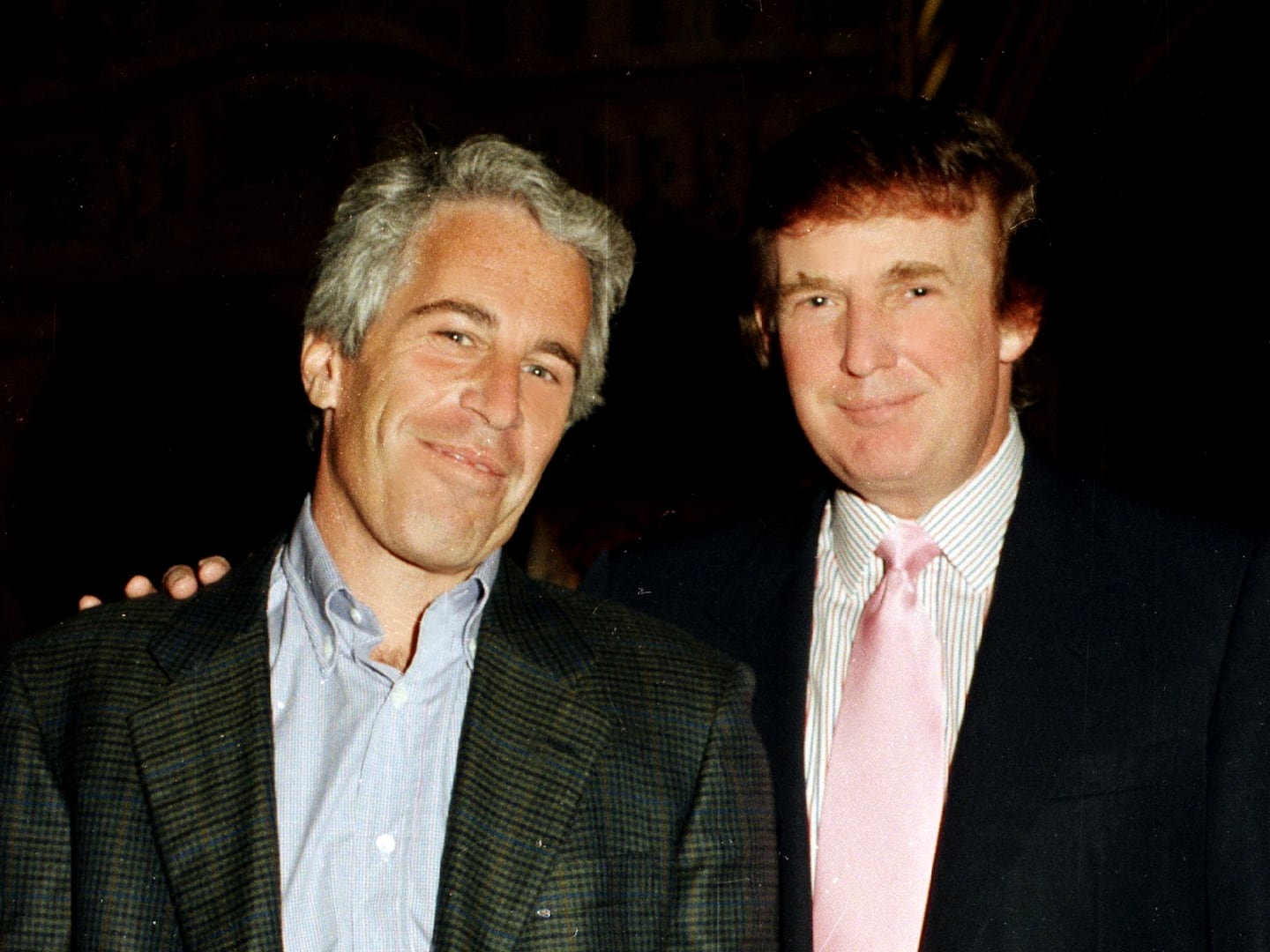In the summer of 2015, a few days after the Supreme Court made legal same-sex marriage the law of the land, the ever-progressive David Byrne hosted an event called “Contemporary Color” at Brooklyn’s Barclays Center. The event, later released as a film of the same name, was organized by Byrne and saw musicians such as Nelly Furtado and St. Vincent performing as high school color guards executed intricate routines. For his own performance, Byrne introduced a song from a musical about Joan of Arc that he was working on, titled “I Was Changed.”
He took a moment to note “America has changed!” and the arena exploded with applause. There was an optimism in the air that night—that summer—and a sense that the world was finally moving forward.
That feeling would prove ephemeral. But he would not be discouraged.
In early January 2018, David Byrne took the stage at the New School in New York City, and—armed with a slideshow, extensive research, and his singularly cool professor charm—did his best to convince the audience, via facts and figures, that they weren’t quite as doomed as they assumed.
At one point, this involved a slide wherein a protester at the Women’s March brandished a misspelled sign reading “Trump Likes Nickleback.” It got a good laugh. Then things took a turn back to heightened sincerity.
Civic engagement is on the rise and that’s a good thing, he argued, and “it cheered me up that so many people were there.” He continued: “The feeling of being together with all of these people was a reward, in and of itself.”
The lauded, halfway-to-an-EGOT songwriter, filmmaker, author, and composer has been making stops all over the world for the past several months as part of his “Reasons to Be Cheerful” multimedia initiative, with a frequently updated website. Whether it’s an essay noting that “Wind Sustainable Power Is Becoming Financially Profitable” or a music video with Detroit school children joyfully covering his current single “Everybody’s Coming to My House”—turning it into what he now views as an anthem of inclusion and confirmation of an increasingly progressive next generation—David Byrne is trying his best to talk us all off the ledge.
As the lead singer of Talking Heads, the former Rhode Island School of Design student-turned-New-York-boho-big-thinker introduced himself to the world via the song “Psycho Killer,” a portrait of rippling inner-city dread set to one of the most jittery grooves in pop history. Coming up at the same CBGB-punk scene that nurtured Television, the Ramones, and Blondie, Talking Heads would go on to walk the axis of pop culture ubiquity and fearless experimentation like few other artists in American history. Albums like Remain in Light would establish Byrne as one of pop music's foremost chroniclers of an existential unease that can never quite be diagnosed or resolved. Given his CV, he is, perhaps, an odd choice for the self-appointed role of global pep talk provider.
But in strange times, we all need to step up.
While many of his peers seem destined to hopelessly chase past glories, David Byrne has always found new ways to challenge himself. Lately, he’s searched for solutions to the world’s problems—and it’s coming along better than you might think. He’s found examples of reforms and technologies that have been proven to work, in an effort to show humanity that we can fix our problems, if only we choose to do so. On his site, he writes about how Vancouver has created “fix rooms” wherein heroin addicts can acquire clean needles and take their intake safely; overdoses and crime have dropped dramatically as a result, and also highlights how prisons in Norway focus on reforming inmates, and their recidivism rate is “20 percent... versus that 76.6 percent in the US over a five-year period.”
On a recent Sunday morning in his SoHo workspace, Byrne notes to The Daily Beast that work on both “Reasons to Be Cheerful” and his acclaimed new album American Utopia began before Trump was elected.
“I could sense that our culture—and Europe’s, and other places—was becoming very divided,” he says. “Problems were not being solved, and yet, the solutions were out there.” He waves his hands a bit. “They’re out there.”
He admits that after watching Brexit and sensing where the free-floating animosity in the world was leading, much of his recent work started as an attempt to—first and foremost—make himself feel better.
“A lot of it is me just trying to give myself a pep talk, but a realistic pep talk. It’s not just feel-good stuff. It’s stuff that has been tried, proven to be successful, adaptable to different cultures and societies and places and all that,” he explains. “So, it’s not just a billionaire gives lots of money to a charity or to a hospital. As much as it’s turning out that way, we can’t expect all the social ills and problems of society to be solved by billionaires.”
Wearing a black fleece, he looks forward when listening to a question, and then cocks his head 30 degrees, not quite making eye contact when answering. Despite the gyrations, his hair always seems to resettle into its signature quiff after every adjustment, always jutting out like an antenna, tuning him into all that is worth paying attention to.
“You’ve just got to look and say, ‘OK, they figured out how to do this, instead of endlessly debating it, just do what they did,’” he continues. “I could see that things were getting into a real kind of mess, and this was way before Trump. I started this as a kind of way to give myself some hope, and a feeling that things were possible, because they are. They are.”
Though the question “What do you think is causing the world’s problems?” might seem an impossibly broad and somewhat-unfair inquiry, when you have an audience with someone who’s clearly thought hard about it, it seems imprudent not to ask.
“I think there are a lot of reasons, and they all have been a perfect storm of all these things coming together,” he replies. “Economically—although in aggregate, people are doing better than they did before—there are huge groups of people whose wages are stagnant; who, in the United States, the dream is dead for them. They don’t see a possibility of moving ahead, of their children doing better than they did.”
He ponders for a second, and then continues: “And that’s true in Europe. It’s compounded by immigrants, where they become a handy scapegoat for all the ills,” he laments. “That happens everywhere. Although it’s been shown, that often immigrants moving into a place actually improve the general economy, rather than draining it. It doesn’t make sense, but you have to blame someone. Whether its Poles in England or Mexicans here, there’s always somebody to blame.”
Byrne himself is a handy example of an immigrant who moved to a country and made it richer: He was born in Scotland and moved to America as a child, and only got his U.S. citizenship six years ago. “I was raised by immigrant parents. So you are raised to be aware that this is how Americans do things,” he recalls. “You often find that wherever you are, whatever country you’re in, people tend to think that their way is the best way, and it’s the only way. And, of course, it’s not.”
“Reasons to Be Cheerful” is his attempt to show there are other ways. And among of the things that encourages him most are examples of conservative lawmakers, such as Texas mayor Dale Ross, breaking from party doctrine and tribalism to embrace something like renewable energy.
And Byrne was well ahead of the curve when it comes to diagnosing the stratifying harm of “us vs them” tribalism. On the Talking Heads’ second album More Songs About Buildings and Food, he wrote the swaying ballad “The Big Country,” in which an unnamed narrator noted of flyover country: “I wouldn’t live there if you paid me to.” He’s always maintained the song is a satire of big-city snobbery, but it hasn’t always been received that way.
“Rather than looking down my nose at people who want to live in a nice apartment building, or whatever, I said, ‘I want to have songs that think from their point of view, so we can feel what people are feeling,’” Byrne explained. “Of course, people viewed it as being incredibly ironic and weird. It was completely out of whack with the kind of angry, punk attitude. But, to me, it seemed more radical than just being angry, so that’s what I did, and I kept doing it.”
It wouldn’t be the last time his social messaging has risked being misconstrued. “I made this film, True Stories. It’s about people in Texas. In some quarters, it was considered to be ironic, and in others, it was considered to be a genuine celebration of the eccentric and self-invented lives of a lot of Americans—and that’s the way Texans looked at it. They enjoyed it.”
There’s been a similar reaction to “Reasons to Be Cheerful,” he says, with some people asking, “Oh, is he really serious? Or is this just some sort of wacky thing?” The question of whether he’s being sincere or “sincere” has lagged him his entire career, with some skeptics refusing to believe that Byrne doesn’t just view the whole of the human experience as grist for an ongoing art project.
“They put quotation marks around everything I do. It might be my voice, the way I sing or something like that. It might be the fact that I might seem a little removed in the way I perform or something, that makes people feel that,” he says. “It might be the fact that I derive pleasure from trying to sort of analyze how music works, let’s say, and a lot of people feel like that is incompatible with my emotional engagement with the music.”
He shrugs. After all, anyone who feels he lacks sincere emotion in his music, or that he views everything is just a high-art concept, just isn’t paying attention.
American Utopia is a natural musical compliment to the “Reasons” initiative, filled with forward-thinking dance-beats, unexpected genre fusions, mile-high choruses, and his signature musings about the nature of all things. But even when he’s pondering how unknowable the universe is, as on “It’s Not Dark Up Here,” Byrne finds a way to make that sound like a good thing—another thing to be hopeful about, another opportunity to find a solution. (“Must a question have an answer / Can’t there be another way?”)
This is Byrne’s first solo album under his own name in 14 years, following album-length collaborations with Brian Eno, St. Vincent, and Norman Cook, among innumerable other projects. After all, he’s the type of guy who makes other high-profile multi-hyphenates look insufficiently ambitious. He’s kept exceedingly busy since Talking Heads officially disbanded in 1991, and in the past few years alone, he wrote How Music Works, which was part memoir and part music theory explainer. He’s designed several architecture-as-instruments public works projects and organized the “Contemporary Color” tour. Perhaps out of fear of seeming idle, he also helped turn Here Lies Love, his album-length collaboration with Cook about the life of the former first lady of the Philippines Imelda Marcos, into a Broadway musical and also wrote the off-Broadway biographical musical Joan of Arc: Into the Fire.
Unlike most artists, his income isn’t tied to any one field, and he doesn’t feel the need to constantly tour and record to make ends meet. “It wasn’t like I sat down and said, ‘I need to put out a record now,’” he says. Byrne would work on the album in between workshops for Joan of Arc, using the extended genesis to continually re-evaluate “and go, ‘Uh, this song is not as good as it should be, or there’s a little confusion in the story-telling here, so I need to make that a little clearer.’ You have time to kind of sleep on it.”
Though there was no sense that “the clock’s ticking,” his friend and longtime collaborator Brian Eno, with whom Byrne has worked since the Talking Heads’ second album, More Songs About Buildings and Food (1978), began sending him drum tracks “that inspired me,” he recounts, and “I had some lyrics that I had, over the years, collected and been working on. All that stuff came together and I thought, ‘Oh, these are turning into songs. Looks like I’ve stepped onto the conveyor belt of making a record, and I may as well ride it out.’”
Though Eno co-wrote and produced much of the album, American Utopia sees Byrne collaborating with a range of musicians with a range of younger musicians including electronic soundscape sculptor Oneohtrix Point Never, avant-R&B producer Sampha, and composer-pianist Doveman.
“Some of them, I’ve never heard of. Bullion, or Happa, or those people,” he says of two British beatmakers recommended to him by friends. “I had no idea who they were. I didn’t know what kind of stuff they did, or what gender, or age, or anything. I didn’t know anything about them. But I thought, ‘Why not?’ Let’s see what happens.’”
Though he insists he can’t keep up with everything, Byrne has always remained engaged with modern music. And unlike many elder statesman, he has never been one to pull a David Crosby and complain that it all sounds like crap nowadays. He was one of the first to champion Arcade Fire, St. Vincent, and Lucius. And in addition to the playlists full of emerging artists such as Arca and Young Fathers that he makes for Spotify, he says that he is also currently “in awe” of Childish Gambino’s Donald Glover, and has ended a few recent live shows with a cover of Janelle Monáe’s anti-police brutality anthem “Hell You Talmbout.”
Byrne is always about the now, even if there’s many who wish he would just pull the big suit from the acclaimed concert film Stop Making Sense out of the mothball-riddled box.
Behind Byrne is a copy of City on Fire, the debut novel by Garth Risk Hallberg that takes place during the height of the New York punk explosion that incubated Talking Heads. He allows that it was a bit odd to see a period he lived through as a young man get studiously recreated in a historical literature milieu, but thinks Hallberg did a good job. Adorning one of the walls in his workspace is the monkey painting that served as the cover for Talking Heads’ album Naked, as well as tightly packed shelves of books, and seemingly endless cabinets filled with ephemera from throughout his career. He muses that maybe one day, when he has time, he might consider turning his archives into a museum exhibit of some sort, perhaps a bit similar to Brooklyn Museum’s current retrospective David Bowie Is.
But the past is not where his focus is right now.
Alongside the Smiths, ABBA, Pink Floyd, and Led Zeppelin, Talking Heads are one of rock music’s great “never, ever, ever getting back together” holdouts. Barring a one-off performance at their 2002 Rock and Roll Hall of Fame induction ceremony, the band haven’t played live since the early ’80s, and Byrne has steadfastly refused to reunite the group, even though a tour would certainly net a huge payday and every festival headliner spot under the sun.
But despite Byrne’s refusal to look backward, his band continues to resonate in popular culture. In the past few years they’ve been covered by Japandroids and sampled by Selena Gomez. Talking Heads fandom and T-shirt possession was used in the recent period pieces Call Me by Your Name and 20th Century Women as semiotic shorthand for the soulful intellect of the main characters, and two different episodes of the acclaimed television series Halt and Catch Fire were named for Talking Heads singles. And as long as directors are making films in which characters feel confused and alienated by their surroundings, “Once in a Lifetime” will have a healthy afterlife making the rounds in film trailers.
While legacy acts from Rush to Slayer to Elton John have recently announced plans to retire, Byrne keeps busier than ever. After a handful of warm-up dates, he’ll launch what he considers one of his most innovative live shows ever. The stage setup involves 12 musicians in constant movement, carrying their completely wireless instruments across the stage, including six different drummers. “In order to get the sound of the drum kit, the percussion, and everything, you have to divide the labor between lots of people." The set will pull from his current album and his solo career, as well as a healthy serving of Talking Heads hits such as “Burning Down the House” and “This Must Be the Place (Naive Melody).” He says he doesn’t mind giving people what they want—within reason.
“I would get tired if I was expected to go out and only play the hits. I’m lucky [with] my audience: they want to hear the hits, but they’re happy to hear the other stuff, too,” he says. “They like a little bit of surprise, but it’s like, ‘You have to give us a little candy, too. Then, we’re happy and thrilled to hear the new stuff.’”
Large-scale music festivals in the past few years have increasingly garnered a reputation for attracting fans that just want to bro out to EDM, and many of the younger attendees of this year’s Coachella may be unfamiliar with Byrne’s solo career or even Talking Heads. But he thinks he’ll be fine.
“What’s really nice about the present day is that a younger audience doesn’t necessarily associate the songs with a particular decade. At least not my music, anyway,” he says. “They don’t always think about it being relevant only to a particular decade. If they like it, they like it as something to listen to, and not like, ‘Oh, I remember when I was in high school in the ’80s, or in the ’70s, or whenever it was.’ There’s people who kind of are new to it, and they go, ‘Wow, yeah. I like this.’ It doesn’t have anything to do with nostalgia for when they were growing up.”
By refusing to look backward, he’s never gotten stuck in an era. Every problem has a solution.






